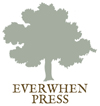
• H O M E •
W R I T E R 'S N I B S
• L I N K S •
B L O G
• C
O N T A C T •
• S
C R I B B L I N G S •
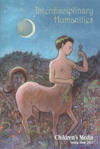
INTERDISCIPLINARY
HUMANITIES
Classroom Comics
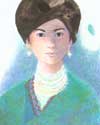
GODDESSES
IN WORLD CULTURE
The Maiden with a
Thousand Slippers

INTERDISCIPLINARY
HUMANITIES
Peter Pan

HORSE
& RIDER MAGAZINE
A Whisper and a Prayer

COURSE CURRICULUM
ARTICLE
Christine de Pizan
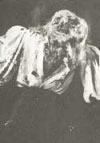
CONFERENCE
PAPER
Hostages
in the Rose Garden
"If you
steal from one author, it's plagiarism; if you steal from many, it's research."
Wilson Mizner, 1876-1933, American Author
(Please use appropriate citations)
This essay was rewritten for general readership and appeared in Primitive Archer Magazine, Summer 2006.
HUNTING THROUGH MEDIEVAL LITERATURE
by Doré
Ripley, ©2004-22
THE SPORT OF HUNTING is described in many texts from the 10th century Beowulf to the mid-15th century, The Weddyng of Syr Gawen and Dame Ragnell for Helpying of Kyng Arthour. Over the span of 500 years, hunting moves from Beowulf’s brutal necessity, with mankind being the hunted, to a feminine sport, as portrayed in Sir Orfeo, Sir Launfal, and The Awntyrs off Arthure at the Terne Wathelyne (Adventures of Arthur). But while courtly hunting is an organized group activity, the lone hunter’s quest is depicted in Ywain and Gawain and Sir Orfeo. Special attention is given to the type of game sought, organization of parties (hunters, hounds men, and related personnel), clothing, hunting calls, dogs, horses, methods of tracking, description of the landscape(s) where game is found and tracked, the type of weapons used, meat preparation and the mood of the group. Brutal violence and graphic dissections are depicted in long descriptive narratives, especially in Beowulf and Sir Gawain and the Green Knight. The hunt is portrayed as sport and/or brutal necessity, whereby the participants act alone or in elaborately outfitted groups to secure game for the table.
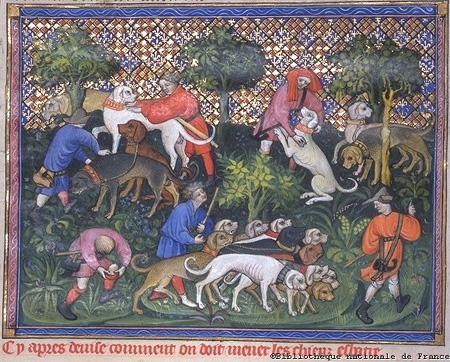
Fig. 1. Preparations for the hunt. (citation, see Index of Selected Illustrations). In this illustration from the 15th century French, Book of the Hunt, the hunters are shown preparing the dogs. They have on tunics and hose, and carry horns. They wear no armor. Some of the dogs are leashed and all wear collars.
– • –
In Beowulf, Grendel is stalking mankind, in the same way Lord Bercilak of Sir Gawain and the Green Knight hunts deer, boar and fox. Grendel contemplates his dinner, when “he thought he would take / the life from each body, eat them all / before day came; the gluttonous thought / of a full-bellied feast was hot upon him” (731a-734b). His narrative feast concludes when he, “seized a warrior, gutted him sleeping---ripped him apart--- / bit into muscles, swilled blood from veins, / tore off gobbets, in hardly moment / had eaten him up, all of the dead man, / even hands and feet” (Beowulf 740b-745a). But Grendel’s days as man hunter quickly come to an end, when he seizes the warrior, Beowulf, “in his claws the strong minded man” (746). “The shepherd of sins then instantly knew / he had never encountered, in any region / of this middle earth, in any other man, / a stronger hand-grip; at heart he feared / for his wretched life” (Beowulf 750a-754a). And when Beowulf slays Grendel, the mood of Beowulf and his companions quickly lifts, “the tried retainers, / the young men too, gay as a hunt, / came from the mere, joyful” (853b-855b).
In the 10th century, the organized hunt is a joyful event. About 350 years later, Sir Orfeo witnesses a women’s hunt where the mood is “[g]entil and jolif as brid on ris” (305), which is repeated in Sir Launfal, whose lady is “[g]entyll, jolyf as bryd on bowe” ( 931). During the third quarter of the 14th century, the hunting Bercilak de Hautdesert, has a magnificent time, “[t]he lord, in his blissful ploy, /…And passed that day with joy” (Sir Gawain 1174-1176), and “[s]till the lord of the land is not lacking in games, / To hunt” (1319-1320). In Sir Launfal the reader is introduced to “Kyng Arthur come from hunting, / Blythe and glad in all things” (709-710). While in The Awntyrs off Arthure on the Terne Wathelyne “many sergeant of mass” (63-63), participate in Arthure’s hunt. At this same hunt, a woman is present as, “[g]ayly she glides. / All in glittering gold” (Awntyrs 26-27). Organized hunts are a happy time, a time of amusement, so in The Weddyng of Syr Gawen, Arthur’s men are bewildered when, after the hunt, “they found the King and the deer / With sembled sad and heavy cheer, / That had no lust to lack” (124-126). Finally, Sir Gawen, “[t]o the Kyng he said then, ‘Sir, me marvel right sore, / What thing that thou sorrowest for’” (Weddyng 138-140). He cannot understand how a successful hunter could be “ryght sore” (Weddyng 138). In any case, if one wishes to participate in hunting amusements, one must be ready before the sun rises.
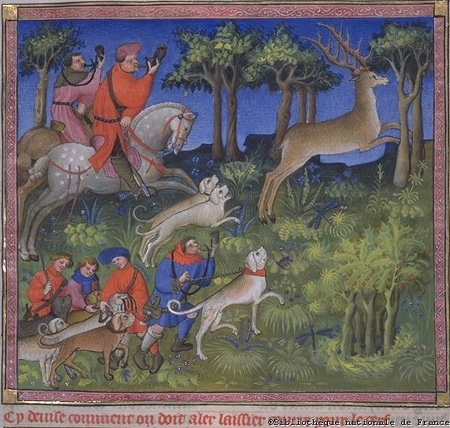
Fig.
2. Stag Hunt. In this illustration, the hunters wear
green camouflage, including leafy headgear, to approach a stag and doe
with crossbows. The hunters
are regally mounted and there are no dogs present.
– • –
Beowulf employs the skills of the hunter when he tracks Grendel’s mother, “[i]n the dark before dawn / the noble champion came with his men” (1311b-1312b), however when Beowulf and his comitatus arrive at her lair, the “[w]ater-beasts, too, lay curled on the cliff-shelves, / that often slither off at dark daybreak” (1427a-1426b). Beowulf and his warriors arrive before daybreak, since the water beasts have not evaporated with the coming of the dawn. One of the best sources for the early morning behavior of sporting hunters is Sir Gawain and the Green Knight. “Full early, before daylight, the folk rise up” (Sir Gawain 1126), and “[h]astily…had breakfast, after having heard mass” (Sir Gawain 1135). On the day of the boar hunt, they are up “[b]y the time the cock had crowed and cackled but thrice, / The lord had leaped from his bed” (Sir Gawain 1412-1413), as “[t]hey galloped toward the forest before the good day sprang” (Sir Gawain 1415). The participants on the morning of the deer hunt find daylight arriving, “[b]efore long” (Sir Gawain 1137), however, on the day of the Sir Gawin's fox hunt, the audience only knows the hunters, “[f]ull early rose upright” (1689). Lord Bercilak’s hunts take place over the Yuletide holidays, and during the fox hunt, “Fully fair were the fields with the frost clinging fast, / As the ruddy red sun rises over the path, / And the clouds in the sky clearly sweep by” (Sir Gawain 1694-1696). This frosty description conjures up the memory of the melting blade found in Beowulf, which “was a much a marvel / as ice itself when the Father unwinds / the bonds of frost, loosens the freezing / chains of water” (1605b-1610a). The reader never learns what time of year Beowulf arrives at Hrothgar’s hall, but the Geats would not cross the open sea during the winter. In The Awntyrs off Arthure the reader knows that Arthure and his hunting party witness an eclipse, because “[t]he day wax all dark / As if it were midnight mark” (75-76). The evidence found in the texts suggest that hunters work in a variety of weather, starting out before dawn, and remaining afield slaying until, “the time the sun sank” (Sir Gawain 1321). Even the lone Tristan, “followed [the stag] until evening” (Beroul 96). But w hile hunters rise before dawn in all weather, they must be able to dress in the dark and approach the field appropriately attired.
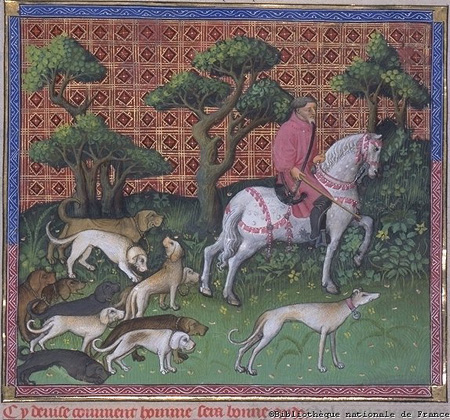
Fig.
3. Setting out for the
hunt. The hunter is on a
well-tacked horse, and wears a hunting horn while carrying a bush-beater’s
stick. The dog in front is a
greyhound, while the dogs behind are hounds.
–
• –
Hunters do not wear armor, and the reader finds Beowulf removing battle gear, in order to give Grendel a fair fight. “He unlaced his chain-shirt, iron body-warden, / undid his helmet” (Beowulf 671a-672b). On the other hand, when Beowulf fights Grendel’s mother we know he is accompanied by “his thanes in their armor” (1626b), who from Beowulf, “they took shirt and helmet, / quickly unstrapped him” (1629b-1630a). Armor is reserved for battles with magical beasts and knightly combat. The audience does not know what the hunters wear in Sir Gawain, only that “[t]he most regal are ready to ride well arrayed” (1130). None of the hunting knights in the The Weddyng of Syr Gawen, dress in armor or chain mail and when the King is attacked by a gnome during the hunt, Arthur scolds him saying, “Shame thou shalt have to slay me in venery, / Thou armed and I clothed but in green” (Weddyng 82-83). This description suggests that the hunters dress in camouflage, wearing green to match the foliage of the forest. In the Awntyrs off Arthure, King Arthur specifically points out, “We are in oure gamen (sporting clothes); we have no gome graithe (armed men)—“ (Awntyrs 436). Women attending hunts as spectators are elaborately dressed, with gowns covered in rich ribbons, rubies, hoods of beautiful hues that"her head hides" and a short cloak that the sheds rain "set over with saphires (Awntyrs 15-21). Organized hunts are a fancy dress affair. The “dukes and dussiperes” (Awntyrs 4), hit the field in the fairest clothes (Awntyrs 9). The best dressed, follow Arthure “within scaghes (thickets)” (Awntyrs 67). In spite of their fancy dress, courtly hunters slog through bushes, and marshes in order to pursue their prey.
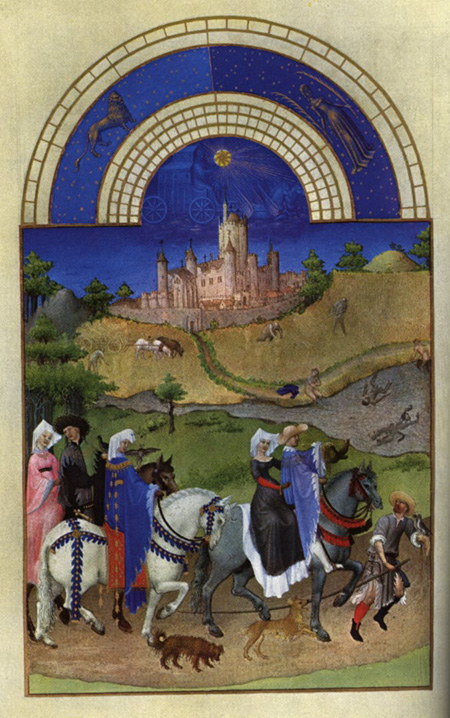
Fig.
4. Hawking Party. Women are seen hunting with hawks accompanied
by men and a servant who also sport birds. The nobles are richly dressed and the illustration
claims they are noble. Hawking
was known as a noble sport. This
illustration from the Tres Riches heures du Duc de Berry, is
for the month of August; the month of hawking. The swimming peasants, in the background, support the notion
of hot August weather. The painting
was done sometime between 1412 and 1416.
While organized hunting can be characterized as a sport of the courtly kind, many texts convey the solitary hunt despicting the man in the wilderness. Beowulf awaits the return of Grendel, the monster hunting the Scyldings in their mead-hall, with his men, “valiant sea-fighters” (690a), of which, “[n]one of them thought he would ever return / from that long hall-floor to his native land” (691a-692b). But, even though they were sure they would all be killed in the upcoming battle, in the end, Beowulf fights alone. Beowulf “overcame / their enemy entirely, by one man’s strength, / by his own powers” (698b-699b). Beowulf takes a mixed comitatus of Hrothgar’s Scyldings, and his native Geats, with him to hunt down, and kill, Grendel’s mother, only to find himself abandoned by the King of Hrothgar’s men, “[t]he valiant Scyldings / gave up the cliff-watch; the gold-friend departed, / went home with this men” (1600b-1602a). However, Beowulf is not entirely abandoned. The men of his homeland, “clustered around him, his thanes… / gave thanks to God for return of their prince” (1626a-1627b). In Beowulf, the comitatus are the men of Beowulf’s homeland, who await his return, while the men of his host, King Hrothgar, abandon their watch. On the other hand, some medieval texts contain a lone man, often found wandering the wilderness, on a quest, or in exile (or both), who needs to hunt for survival. In The Romance of Tristan, the two lovers find themselves banished to the woods where, “Tristan took aim at a stag and shot an arrow that pierced its side. The stag fled and Tristan gave chase” (Beroul 96). Tristan’s lover, Yseut, can hardly be described as a comitatus, while in Sir Orfeo, the protagonist is found wandering completely alone in the woods. There is no description of Sir Orfeo hunting only, “digging to find his fill of root and in summer he lived by wild root" (255-257). However, Sir Orfeo witnesses’ fairy hunts with, “[t]he King of Fairy with his rout, / Come to hunt him all about” (282-283). The fairy noble women also hunt, and ride in a feminine comitatus of “[s]ixty ladies” (Sir Orfeo 304), with “[n]ought aman among them there is” (Sir Orfeo 306). So, even the fairies, both men and women, recognize the value of the comitatus when hunting. Sir Launfal presents another female comitatus who arrives with, “[a] damsel alone” (927), with “[a] gerfalcon she bear on her hand” (961), and “[t]wo white greyhounds run her by—“ (966). The gerfalcon indicates her noble status, and she is accompanied only by, “[h]er maidens come ayens her, right,” (Launfal 976). However, the audience knows she is a “fayre” (Launfal 1034), displaying the vestments of hunting, while never actually engaging in a hunt. Meanwhile, Sir Ywayn in Ywain and Gawain rambles in the woods for a “full fele year” (1708), until he runs across a lion and dragon fighting, and saves the lion’s life, who then “followed by his side” (2012), “[a]nd never for wele ne for wa / Wald he part Sir Ywayn from” (2015-2016). So, in Sir Ywayn’s case, a solitary lion replaces the hunting party or comitatus.
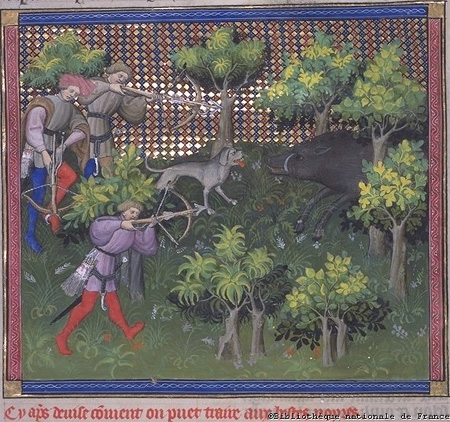
Fig.
5. Boar Hunt. The boar is being hunted with cross
bows and dogs and has turned on the hunters inside a thicket, a very
dangerous position for both dogs and the hunters.
–
• –
Sir Gawain and the Green Knight’s three hunting scenes depict the excitement of a royal hunt with all its fanfare and accoutrements.“ Guests going hunting called for their grooms” (Sir Gawain 1127), while “[t]he liege lord of the land was not the last one / Arrayed for the riding, with retainers full many” (Sir Gawain 1133-1134). In Sir Gawain there is a distinction made between guests and hunters.Guests are provided for and guided, while the hunters seem to be vassals of the lord, “[t]he noblest knights went there with men wise in their craft” (Sir Gawain 1325), while, “the lord on the land, leading his games” (Sir Gawain 1894) directs the hunters who, “hastened to that place with horns so many, / Blowing recheat aright until they reached the lord. / When his noble company had all gathered there” (Sir Gawain 1910-1912). The Lord’s knights are thanes of Bercilak’s, or his comitatus, visiting for the Yuletide holiday. The abundance of servants only displays Bercilak’s wealth, with beaters, buglers, dog handlers, and grooms attending his hunting guests.The only visitor seen arriving at the court of Lord Bercilak is the lounging Sir Gawain, who never participates in any hunt.
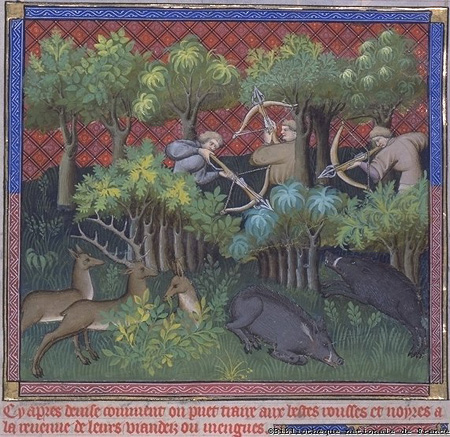
Fig.
6. Boar and Stag hunt. The hunters are using crossbows while
hiding in a blind, behind trees, like Kyng Arthoure.
– • –
In The Awntyrs off Arthure, the reader is immediately feted with a royal hunt, where “[b]oth the Kyng and the Quene / And al the doughti bydene” (10-11) participate. In this hunt, women come as spectators and are accompanied by knights, such as Sir Gawayn who, “Dame Gaynour he leads” (Awntrys 13). The King is in charge, “[a]nd Arthur with his earls ernestly rides / To teach them to her tristes” (Awntrys 33-34), where “[e]ach lord without letting / To an oak he them set” (Awntrys 36-37). The king is in charge of showing the men where to hide and await their prey. There are also “many sergeant of mass” (Awntyrs 64), who would not qualify as a part of the king’s comitatus, or as Knights of the Round Table, but as servant fighters and hunters. The Weddyng of Syr Gawen virtually opens with the same hunting scene as The Awntyrs off Arthure, where “Arthur the King, / How once him befell--/ On hunting he was in Ingleswod / With all his bold knights good—“ (Weddyng 14-17). However, Arthur soon commands his men to remain behind, “Hold you still, every man, / And I will go myself, if I can-- / With craft of stalking.’” (Weddyng 28-30). King Arthur gives up his comitatus to become the solitary knight on a chivalric quest while chasing a “deer leapt forth into a briar” (Weddyng 35). He must be alone to run across the evil gnome that drives the story’s plot. Even while Arthur scrambles through briars on his lone hunt, many of the texts examined here give the audience a vivid picture of the countryside through which the myriad hunters cavort, looking for prey.
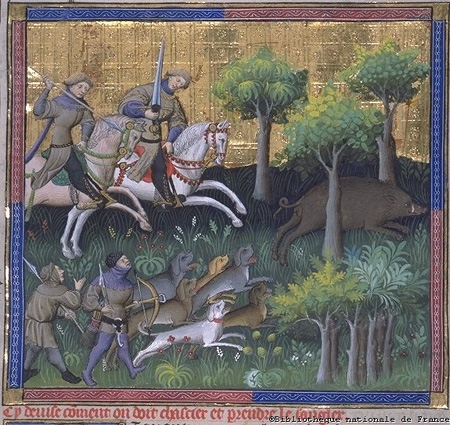
Fig.
7. Boar hunt with sword. Like Lord Bercilak, the mounted hunter
pursues the boar with a blade, while his compatriot carries a lance
and the hunters use crossbows and dogs.
–
• –
In Beowulf, Grendel’s mother is tracked “through the wood-paths” (1403b) to the “stony hills, the steep rock-lands, / through narrow files, an unknown way, / dangerous cliffs over water-snakes’ caves” (1409a-1411b). The king leads the way, “till suddenly he came / upon stunted firs, gnarled mountain pines / leaning over stones, cold and gray, / a joyless wood. The water beneath / was stirred with blood” (Beowulf 1413b-1417a). Much of the descriptive narrative of Beowulf is devoted to battle, booty, and the mead-hall; little is given over to landscapes, imaginary or real. In Sir Orfeo we know the male fairies are hunting in the woods because that is where “[t]his king sufferd ten years and more” (264), but, the reader does not know what game they are seeking because the fairies are unsuccessful hunters. Meanwhile the fairy women are hunting near water where “[t]he fouls of the water arise” (Sir Orfeo 311), slaying “[m]allards, heron, and cormeraunt” (Sir Orfeo 310). Sir Ywayne, of Ywain and Gawain, hunts where he lives, “[i]n the wodd” (1667), as he “ran he forth into the wood ” (1687), hunting “venison” (1668). When Ywayne meets his sidekick, “[t]he lion” (Ywain 2017), the lion does the hunting, “in the forest” (Ywain 2016), where he kills “barren deer” (Ywain 2027). Sir Gawain and the Green Knight takes the audience through the individual landscapes of deer, boars and foxes. They hunt deer “through the dale” (Sir Gawain 1151), driving does “to the very deep valleys” (Sir Gawain 1159), while, “the lord gallops gallantly along linden woods’ borders” (Sir Gawain 1178). Lord Bercilak hunts boar “among those thorns” (1419), and “by the side of a marsh” (1421). Finally, the boar is trapped, “[b]etween a pool in that forest and a forbidding precipice. / On a knoll by a cliff near the cold marsh, / Where the rough stony slope swept down dangerously, / They fared to the finding, followed by the men. / They circled the crag and the close-by knoll” (Sir Gawain 1430-1434). The exhausted boar, “gets to a cleft, / Where a rivulet ripples in a channel by a rock. / He had the bank at his back” (Sir Gawain 1569-1571). In the final fox hunt of Sir Gawain, the hunters pursue their wily prey across “fields with the frost clinging fast” (1695), to a “holt thick with trees” (1697), who then “twists and turns though troublesome thickets, / Doubles back and harkens by bushes full often. / At last by a little ditch he leaps over a hedge, / Slips away very silently by a secluded wood” (1707-1710), but in spite of the fox’s elaborate dodgings, Sir Gawain soon catches up with him. The Awntyrs Off Arthure offers myriad descriptions of hunting country, where “they them looked to the deep dells / To fall the females in forest frydde” (6-7). They also hunt barren does, who “[t]hen durken the dere in the dymme skuwes (woods) / That for drede of the death droupes the do. / [And by the stremys so strange that swithely swoghes] (Awntyrs 53-55). The deer eventually find their way to “schaghes (thickets)” (Awntyrs 67). The hunt ends before it ever really gets started, as the story shifts to Sir Gawayn and Dame Gaynour. In The Weddyng of Syr Gawen, the reader is treated to the description of a hunting blind, “[t]he Kyng was set at his trestyll-tree” (19), but ends up chasing a “hart was in a bracken fern” (25), where a “deer leapt forth into a briar” (35). However, this time the Kyng is not hunting does, he is hunting stags. But while the hunters chase their game through all different kinds of country, how do the hunters slay them?
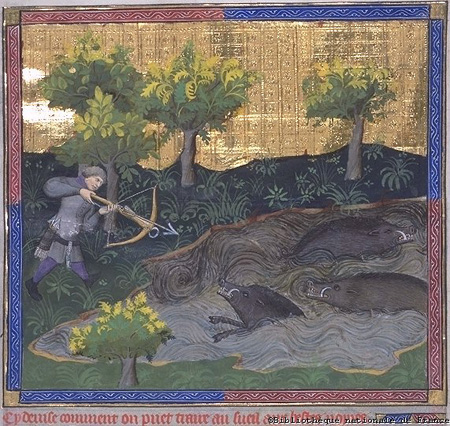
Fig.
8. Boar hunt in water. As in Sir Gawain and the Green Knight,
the boars are pursued into water. The hunter uses a crossbow.
–
• –
After Beowulf moves from hunted to hunter, he kills Grendel by hand. The fight is contained within a narrative that describes not only the battle, but Grendel’s regret at running across Beowulf, Beowulf’s boasting, and the destruction of the mead hall. When “the evil assailant / snatched at him, clutching; hand met claw, / he sat straight at once, thrust the arm back” (Beowulf 747b-749b). Grendel discovers “he could not move” (Beowulf 754b), and Beowulf “rose to his feet / and held him close; fingers snapped; / the giant pulled away, the noble moved with him” (Beowulf 759b-761b). Grendel “felt his fingers / in a terrible grip” (Beowulf 764b-765a), and “[a] sound went out, loud and high, / raised horrible fear in Danish hearts” (783a-784b). Finally, “[t]he terrible creature / took a body wound there; a gaping tear / opened in his shoulder; tendons popped, / muscle slipped the bone” (Beowulf 815b-818a), and “Grendel fled, / wounded, death-sick,” (Beowulf 819b-820a), “with that huge wound / he knew for certain his life had ended” (Beowulf 821b-822b). Beowulf rips off Grendel’s arm “from hand to shoulder” (835a), and mounts it “under the high roof” (836b) of the hall. In Beowulf’s second battle, he takes on Grendel’s mother. “Terror was the less / by just so much as the strength of women, / attack of battle-wives, compared to armed men” (1282b-1284b). The reader learns that women participated in battles, and were just slightly weaker than men, and as previously noted, they also participate in organized hunts. Grendel’s mother is out to revenge the death of her son and after murdering one of the king’s loyal retainers, she “seized in its gore / the famous claw-arm” (Beowulf 1303b-1304a). Beowulf tracks her to an underwater den and they engage in a long battle using knives and swords. Finally, Beowulf grabs a blade, “from its magic scabbard, / savage in battle-lust, despairing of life, / angrily raised the shearer of life-threads, / swung hard on her throat, broke through the spine, / halved the doomed body; she toppled to the ground: / the sword was blood-wet” (1564b-1569a). He searches her lair, discovers Grendel’s body, “armless, lifeless from the hurt he’d received / in the fight at Heorot. The corpse sprang open / as he cut deep into it after death, / a firm-handed battle-stroke, and chopped off his head” (Beowulf 1587a-1590b).
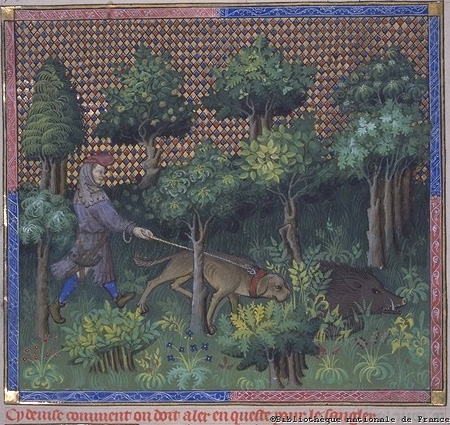
Fig.
9. Dogs scenting a boar. A lone leashed dog and huntsman track a
boar a field through overgrown country.
The huntsman carries a hunting horn.
–
• –
Medieval audiences and authors loved explicit violence, and a variety of weapons. In The Romance of Tristan, Tristan hunts with a bow. In Ywain and Gawain, Sir Ywayn “[s]hot him a wild beast” (1664), with an arrow while the lion treats the audience to graphic a hunt, “[a]nd full soon he gane her slay; / Her throat in twain full soon he bite / And drank the blood while it was hot” (228-230). The fairy ladies of Sir Orfeo let loose, “[t]he falcons them well deviseth: / Each falcon his prey slew. / That sees Orfeo, and laughs; / ‘Parfay!’ says he, ‘there is fair game!” (312-315). The male fairies use, “dim cries and blowing, / And hounds also with him barking” (285-286). Lord Bercilak in Sir Gawain and the Green Knight employs every hunting resource available to medieval man. The hunters are mounted “on high horses” (Sir Gawain 1138), and use “hounds” (Sir Gawain 1139), “charged to go chasing unchecked” (Sir Gawain 1143), “bugles” (Sir Gawain 1141), “loud horns” (Sir Gawain 1165), and a “ring of beaters” against deer, who sometimes escape, “the slanting of arrows. / At every turn in the woods an arrow whizzed by” (Sir Gawain 1160-1161). But those arrows most often “bit firmly with broad heads into the brown hide. / What! They bray and bleed. On the banks they die” (Sir Gawain 1163-1164). “The greyhounds so huge, who got to them quickly, / And flew at the deer as fast as fellows might see, and smite” (Sir Gawain 1172-1173). To hunt boar, they use “hounds” (Sir Gawain 1422), “forty at once” (Sir Gawain 1425), and many dogs are wounded as the boar, “bites at the backs of the best of his raches” (Sir Gawain 1563). Unlike the deer, the arrows have no effect on the boar, as “the barbs would not bite into his bristly brow” (Sir Gawain 1458). Finally Lord Bercilak engages the boar single handedly
The swine springs out swiftly, straight at the lord,
So that the brave one and the boar were both locked together
In the wildest current of the water; the worst had that other,
For the man marks him well when they met at first,
Set surely the sharp sword straight in the slot,
Shoved it up to the hilts, so that the heart split,
And
he, with frantic yowling, yielded and floated downstream,
in fright.
A hundred hounds amassed;
That beast they then did bite.
On the field the creature was cast,
And dogs slew him on that site. (Sir Gawain 1589-1600)
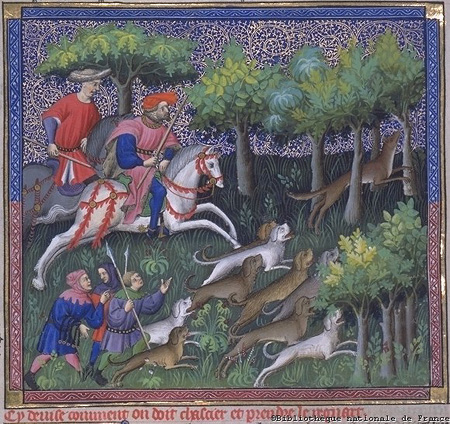
Fig. 10. Fox hunt. A hunting party tracks a fox into the woods using dogs, lances and sticks. One of the hounds men carries dog leashes.
– • –
Even though Sir Bercilak delivers the deathblow, the dogs that the boar, “had hurt so many before” (Sir Gawain 1576), were allowed the kill. The third foxhunt in Sir Gawain is lead by “small hound howls, calls the hunters on the beast; / His fellow hounds scamper fast, sniffing for the fox” (1701-1702). The fox gives the hounds quite a chase, until he is trapped, “right before the horse’s feet they all fell upon him, / And worried this wily one with wrathful noise (Sir Gawain 1904-1905). The only weapon raised against Reynard is the Lord’s “shiny sword” (Sir Gawain 1901), which “strikes at the beast, / Who swerved from the sharp blade with a sudden turn” (Sir Gawain 1901-1902). The lord “[s]natched him full swiftly from strong jaws of the dogs” (Sir Gawain 1907), but nevertheless gives it to, “[t]heir hounds they then reward, / Stroking their heads with pride, / From Reynard who once had soared, / They strip his scrawny hide” (Sir Gawain 1918-1921). Likewise, the hunters in The Awntyrs off Arthure, gave no quarter to “gamon [or grythe] that on grounde gruwes” (59). There are no weapons mentioned in this narrative, only chasing by the “hound and with horn” (Awntyrs 435), and, “[w]ith fresh hounds and fele their folowne her fare. / With gret questes and quelles (slayings)” (Awntyrs 48-49). They use “grete geundes [greyhounds]” (Awntyrs 60), while “[t]he king blowe rechas / And folowed fast on the tras,” (Awntyrs 62-63). Kyng Arthour in The Weddyng of Syr Gawen is no stranger to violence, and after wounding his deer with his “bowe” (31), “att the last he let fly” (40), he “both ferce and fell, / Was with the dere and dyd hym servell (dashed out his brains)—“ (46-47). After the hunters slay their quarry using swords, arrows, beaters, horns, dogs, falcons, and their bare hands, many texts give a recitation of how medieval game was prepared.
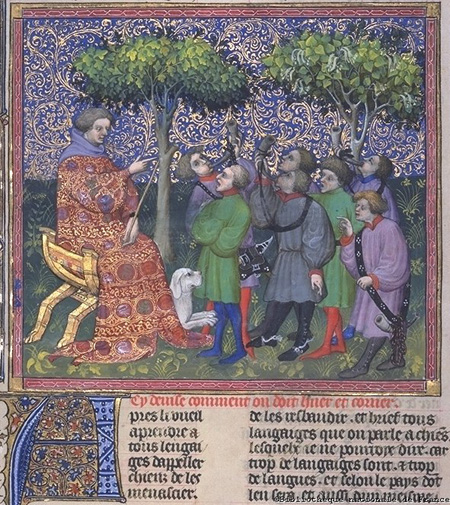
Fig. 11. Teaching how to sound the hunting horn. The bugle was an important part of the hunt, used to track and keep track of hunters, dogs and game.
– • –
In Ywain and Gawain, Sir Ywayne lives in the wilderness, “a great season” (1667), and is reduced to eating “raw venysowne” (1668), drinking “of the warm blode” (1669). During his solitary exile, he runs across a hermit, to whom he provides venison. The hermit “[b]rede and sothen venysowne” (Ywain 1701); raw, broiled or boiled, the two men eat deer meat exclusively. When Sir Ywayne’s comrade lion kills a doe, the animal cleans it, “[t]he lion had the da undone” (Ywain 2041), while “Sir Ywayne made a spit ful sone / And roasted some to their supper” (Ywain 2043-2044). However, the lone exile does not practice the elaborate butchery procedures like those found in Sir Gawain and the Green Knight. These lengthy descriptive narratives are meticulous, step by step instructions, on how to flay, butcher and render deer and boar. The deer hunters of Sir Gawain and the Green KnightGathered the fattest of deer favored by the group,
And did skillfully slit them open, as the deed requires.
Searching them at the assay were some who were there;
Two fingers of fat they found on the poorest.
Then they slit the slot, seized the first stomach,
Scraped it with a sharp knife, and the shiny flesh tied.
Next they lopped off the four limbs and flayed the hide;
They then broke the belly, and the bowels took out
Expertly to prevent loosening and loss of the knot.
They gripped the throat and thoroughly divided
The gullet from the windpipe, and threw away the guts;
Then they sheared off the shoulder-blades with sharp knives,
And slid them through a little hole to have whole sides.
They slit each beast’s breast and separated it in two,
And again at the throat one begins anew,
Cuts it open quickly clear to the fork,
Voids out the viscera, and verily thereafter
All the membranes along the ribs they readily loosen;
Fiercely they flay them off, those found by the back bones,
Trimmed to the haunch what hung there all together,
And heaved it up all whole and hewed it off there,
And they denote that as the numbles by name, as I believe, by kind.
All along the fork of the thighs
They loosen the flaps of flesh behind;
Then to cut in two each prize,
By the backbone they unbind.
Both the head and the neck they hack off next,
And then they sever the sides swiftly from the spine,
And the corbie’s fee they flung in a grove.
And then they thrust through each thick side by the ribs,
And hung both high by the hocks of the haunches
Each fellow securing the share that is fitting to have.
Upon a skin of splendid beast they sated their hounds
With the liver and lungs, the lining of stomachs,
And bread bathed in blood, blended theramong.
(Sir Gawain 1326-1361)
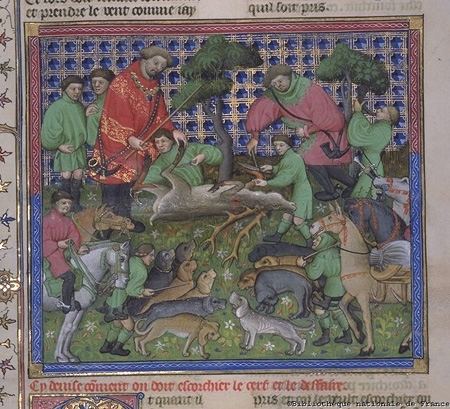
Fig.
12. Cutting up the stag. This illustration presents the hunting
party field cleaning a stag by first slitting the neck and flaying the
skin from the legs. Present
is the beautifully dressed Lord, and his many hunters dressed in green. We also see horses and a pack mule. The dogs seem very interested in the preparations
while a hunter sounds the recheat (upper right), or gathering call of
the hunt.
–
• –
This long and detailed description is not interrupted by battles, or destruction, or regret, or boasts. It tells the audience how to prepare deer in the field, and how to properly reward the hounds. The same is repeated after the boar is slain, though the description is not nearly as long
Then a worthy woodsman who was wise in woodcraft
Begins with care to carve this board.
First he hews off his head and on a high stake sets it,
And then rends him in the rough right along the backbone,
Extracts the beast’s bowels, broils them on coals.
Rewards his raches with the repast and bread.
Then he slits meat boldly in bright, broad slabs,
And hacks off the haslets from the huge creature,
And the halves of that hog all whole does he fasten,
And hangs them high on a hardy pole. (Sir Gawain 1605-1614)
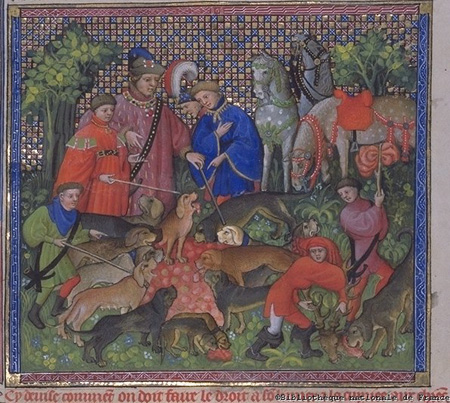
Fig.
13. Fleshing the hounds. The pack is rewarded for their efforts
during the hunt. Present are
finely dressed nobles, well-tacked steeds and the hounds men who watch
over the dogs with sticks. At
lower right, a hounds men appears to be giving the head and neck of
a stag to a dog while holding its horns.
–
• –
The descriptive, “hews off his head” to stake it, is reminiscent of Beowulf’s chopping off of Grendel’s head which he takes back to the mead-hall as a trophy. Likewise in Sir Gawain, “the boar’s head was borne before the lord himself” (1616), and taken to the court as a trophy. The medieval organized hunt was an elaborate affair that not only involved the killing of game, but the preparation of butchered flesh.
There are two types of hunts depicted in medieval literature, the courtly affair of sport, or the lone labor of necessity. The courtly hunt involves men and women working in groups to secure meat for the table, where, often times, a hunter becomes separated from the group. While Beowulf started out as the hunted, he becomes the solitary hunter-warrior like those found in many of the later texts. Both men and women enjoy the sport, starting out early in the morning, in a variety of weather, and remaining a-field until sundown. Hunters dress richly and appropriately for both weather and camouflage. The medieval weapons assemblies for hunting, as depicted in the surveyed texts, includes arrows and bows, crossbows, horns, dogs (hounds and greyhounds), swords, hounds men, bush beaters, gyrfalcons, hawks, and even a lion. The terrain of the hunted deer, boar and fox vary, though most hunts occur in, or near, forests. In medieval hunting literature, the hacking and hewing of battle is translated into detailed descriptions of violent animal kills, coupled with the proper field dressing necessary to prepare meat for the table. It appears today’s audiences are not the first to enjoy explicit depictions of violence, but while medieval audiences viewed graphic spectacles within their minds, today’s viewers sit back and absorb images flashing across a flat screen.
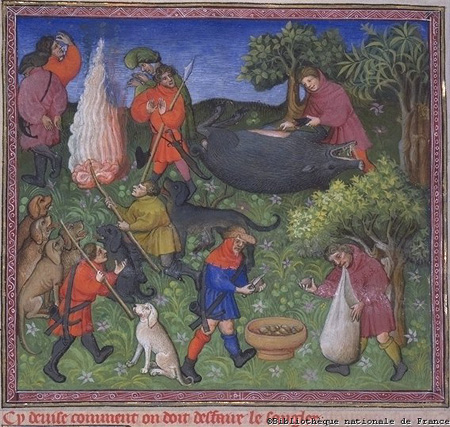
Fig. 14. Cutting up the boar and fleshing the hounds. The viewer sees the field preparation of a boar who has been gutted. The two men in the foreground may be adding bread to blood in order to flesh the hounds as described in Sir Gawain and the Green Knight.
–
• –
Works Cited
Awntyrs off Arthure at the Terne Wathelyne. Middle English Romances. Ed.Stephen H.A.Shepherd. New York: Norton, 1995. 219-243.
Beowulf. Trans. by Howell D. Chickering, Jr. New York: Random House, 1989.Beroul.
The Romance of Tristan and The Tale of Tristan’s Madness. Trans. by Alan S. Fedrick. London: Penguin, 1970.
Sir Gawain and the Green Knight. Ed. and trans. by William Vantuono. Indiana: U of NotreDame P. 1999.
Sir Launfal. Middle English Romances. Ed. Stephen H.A. Shepherd. Ne York: Norton, 1995. 190-219.
Sir Orfeo. Middle English Romances. Ed. Stephen H.A. Shepherd. New York: Norton, 1995. 174-190.
Ywain and Gawain. Middle English Romances. Ed. Stephen H.A. Shepherd. New York: Norton, 1995. 75-173.
Index
of Selected Illustrations
Boar Hunt. Gaston Phoebus, Book of the Hunt. Bibliotheque nationale de France(BNF, FR 616, fol. 116). France: Paris, 15th century. 16 August 2004. <http://www.bnf.fr/enlum bin/afiche.exe?a5_0079.htm&/enluminure...>.
Boar Hunt in Water. Gaston Phoebus, Book of the Hunt. Bibliotheque nationale de France (BNF, FR 616, fol. 117). France: Paris, 15th century. 16 August 2004. <http://www.bnf.fr/enlum bin/afiche.exe?a5_0080.htm&/enluminure...>.
Cutting up the boar and fleshing the hounds. Gaston Phoebus, Book of the Hunt. Bibliotheque nationale de France (BNF, FR 616, fol. 73v). France: Paris, 15th century. 16 August 2004. <http://www.bnf.fr/enlum- bin/afiche.exe?a5_0045.htm&/enluminure...>.
Cutting up the stag. Gaston Phoebus, Book of the Hunt. Bibliotheque nationale de France (BNF, FR 616, fol. 70). France: Paris, 15th century. 16 August 2004. <http://www.bnf.fr/enlum-bin/afiche.exe?a5_0042.htm&/enluminure...>.
Dogs scenting a boar. Gaston Phoebus, Book of the Hunt. Bibliotheque nationale de France (BNF, FR 616, fol. 66). France: Paris, 15th century. 16 August 2004. <http://www.bnf.fr/enlum-bin /afiche.exe?a5_0039.htm&/enluminure...>.
Hawking Party. Paul, Herman, Jean Limbourg. Les tres riches heures du Duc de Berry. Chantilly musem, France. 1412-1416. 16 August 2004. <http://www.ibiblio.org/wm/rh/img/august.jpg>.
Preparations for the hunt. Gaston Phoebus, Book of the Hunt. Bibliotheque nationale de France (BNF, FR 616, fol. 53). France: Paris, 15th century. 16 August 2004. <http://www.bnf.fr/enlum- bin/afiche.exe?a5_0026.htm&/enluminure...>.
Setting out for the hunt. Gaston Phoebus, Book of the Hunt. Bibliotheque nationale de France (BNF, FR 616, fol. 75v). France: Paris, 15th century. 16 August 2004. <http://www.bnf.fr/enlum-bin/afiche.exe?a5_0046.htm&/enluminure...>.
Stag hunt. Gaston Phoebus, Book of the Hunt. Bibliotheque nationale de France (BNF, FR 616, fol. 113v). France: Paris, 15th century. 16 August 2004. <http://www.bnf.fr/enlum-bin /afiche.exe?a5_0074.htm&/enluminure...>.
Teaching
how to Sound the Hunting Horn. Gaston
Phoebus, Book of the Hunt. Bibliotheque nationale de France (BNF,
FR 616, fol. 54). France: Paris, 15th century. 16 August 2004. <http://www.bnf.fr/enlum-bin
/afiche.exe?a5_0028.htm&/enluminure...>.
